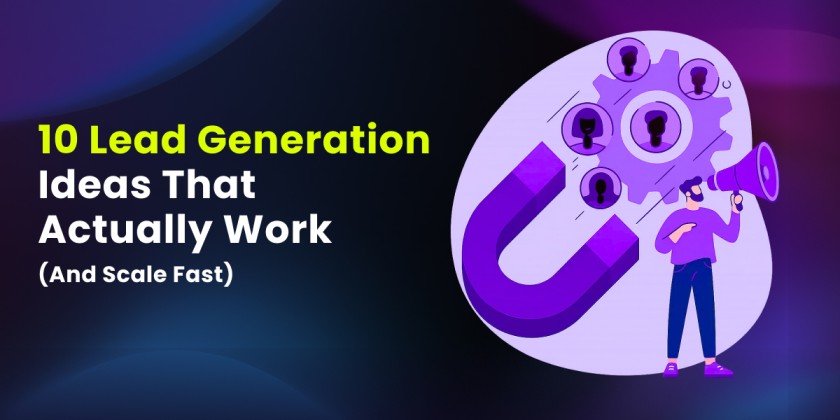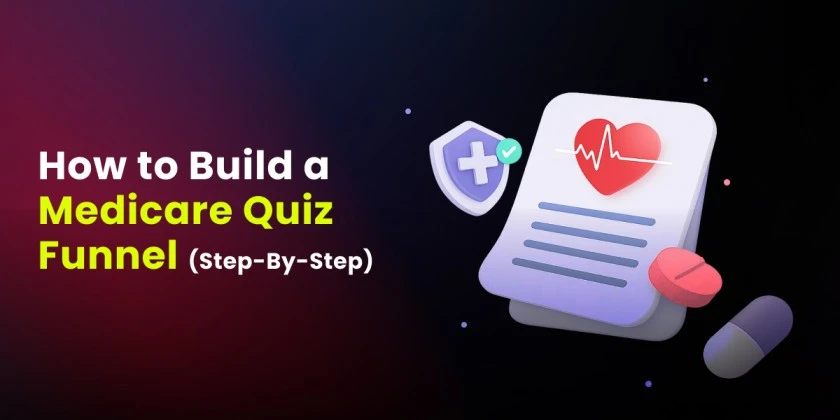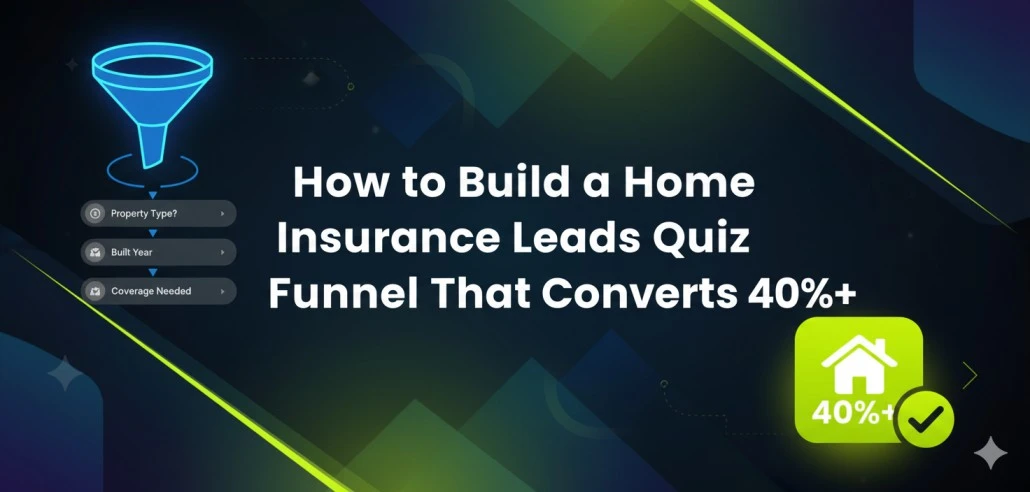The marketplace is a battlefield, and your business is either capturing new territory or watching competitors swallow your market share. No middle ground exists.
This comprehensive guide cuts through marketing fluff to deliver battle-tested lead generation tactics that actually put prospects in your pipeline. With the right lead generation efforts, you’ll learn how to generate leads consistently across multiple lead generation channels.
The Lead Generation Landscape: Brutal Truths
Let’s get real about what we’re up against in today’s competitive market:
- Every business is screaming for attention across identical lead generation channels
- Ad costs have skyrocketed while returns diminish
- Privacy regulations keep choking your data collection capabilities
- Customers expect personalized experiences, but hide their data
- The content apocalypse makes standing out nearly impossible
Sounds bleak, right? It is for businesses using outdated playbooks. But for those willing to adapt and execute with precision, huge opportunities exist.
Key Takeaways
Effective lead generation efforts are critical for business growth in this environment. This guide arms you with actionable tactics organized into three strategic arsenals.
- Digital Lead Generation Strategies: Online techniques for maximum reach and measurement across different channels
- Face-to-Face Lead Generation Strategies: Offline methods that still devastate when digital gets tuned out
- Partnership-Based Lead Generation: Partnership strategies that multiply your forces
Each section delivers immediately applicable tactics with zero fluff. By the time you finish, you’ll have a comprehensive arsenal to crush your lead generation goals and engage potential customers more effectively.
These strategies will help you create successful lead generation campaigns that drive business growth. Let’s hunt.
Digital Lead Generation Strategies
Online channels offer some of the most cost-effective and measurable marketing channels to generate high quality leads. Understanding which lead generation channels work best for your business is essential.
Let’s explore the most powerful digital marketing strategies you can implement to generate leads consistently:
1. Search Engine Marketing (SEM/PPC): Intercept Buyer Intent
When someone actively searches for solutions you provide, they have purchase intent. Search engine marketing puts you directly in their path through search engines.
How to implement SEM effectively:
- Start with keyword research: Deploy Google Keyword Planner to identify high-intent search phrases. Look for specific language patterns that reveal buying readiness, not general information research.
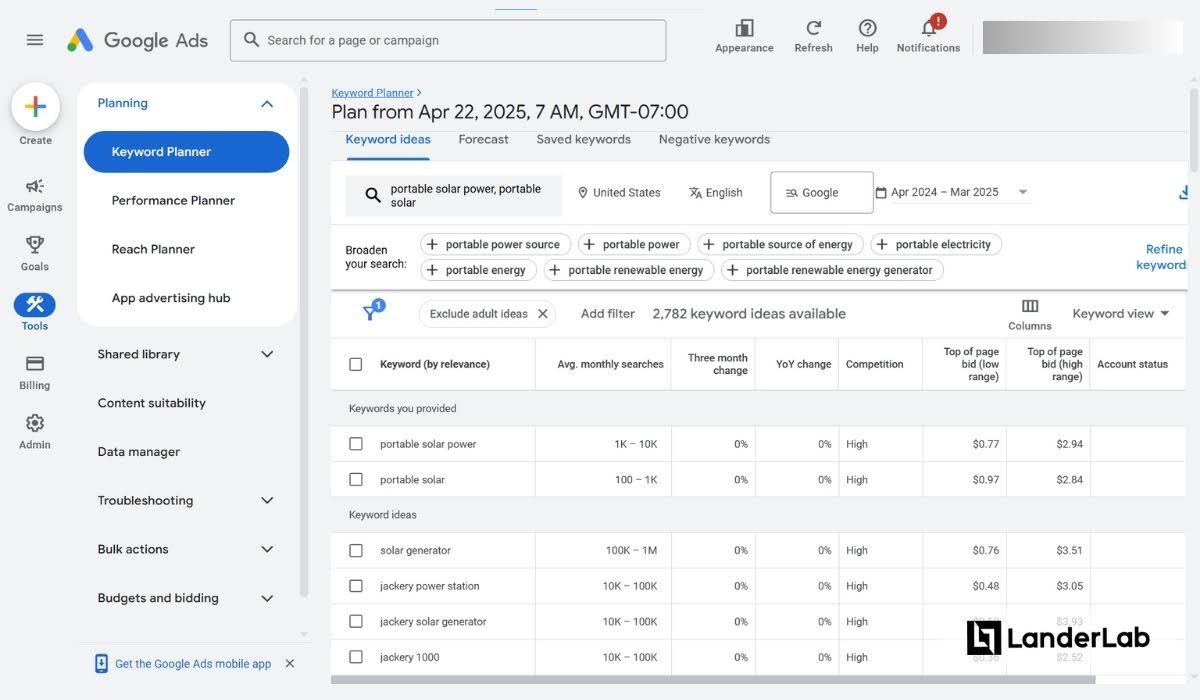
- Create targeted ad groups: Group related search terms into tight tactical units. This improves your quality score and lowers your cost per click.
- Write compelling ad copy: Highlight specific value propositions that differentiate from competing messages. Include unmistakable and powerful calls-to-action that initiate engagement.
- Build dedicated landing pages: Develop focused conversion landing pages that deliver precisely what your ad promised. Eliminate distractions and maintain message consistency. Streamline data capture to essential form fields only. Use landing page builders like LanderLab to make page creation easier and on point.
- Set up conversion tracking: Implement comprehensive tracking to identify which keywords and paid ads generate qualified leads versus mere clicks.
Pro Tip: Reserve 10-15% of your advertising budget for remarketing to site visitors who showed interest but didn’t convert. These campaigns typically deliver superior ROI compared to cold targeting, produce more qualified leads, and can reduce your customer acquisition cost. We’ll discuss this in more detail later.
2. Content Marketing & SEO: Establish Strategic Territory
Content marketing isn’t about blogging it’s about creating strategic assets that capture audience attention and establish authority in specific niches.
When combined with search engine optimization, these assets become lead-generating outposts that work 24/7.
How to build an effective content marketing strategy:
- Identify your target audience’s questions: Do your research. Use tools like AnswerThePublic to uncover information gaps your potential customers need filled.
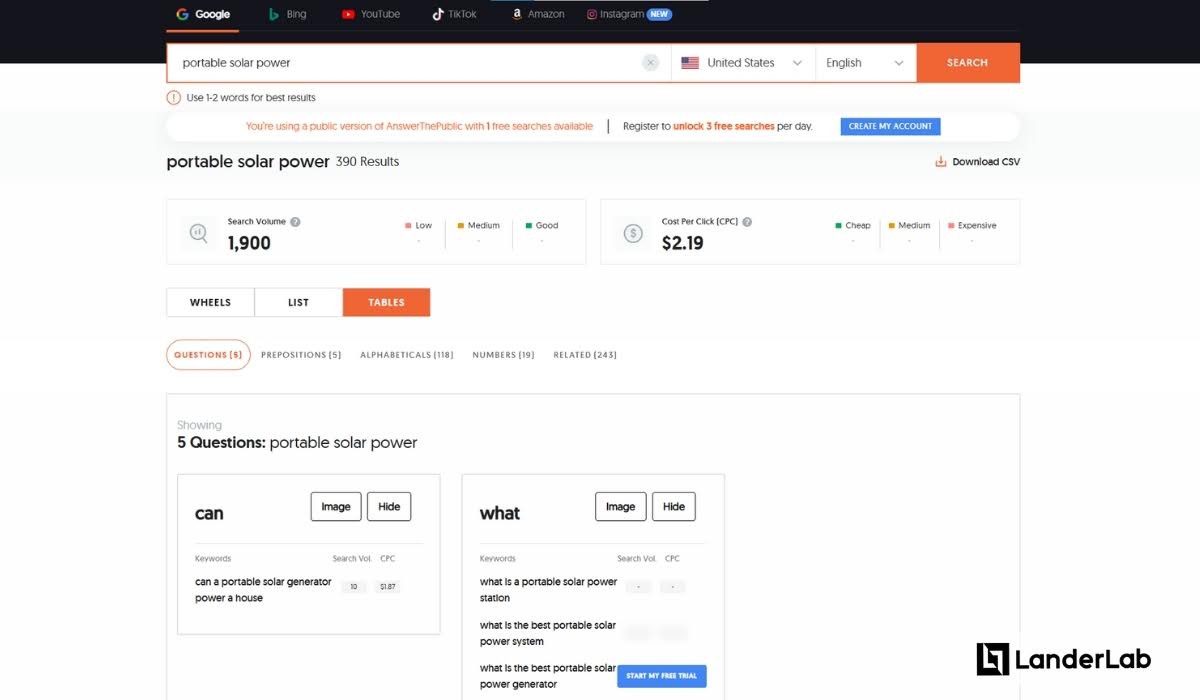
- Create high-value content: Create superior information resources that outperform competing content. Focus resources on producing fewer, higher-quality assets rather than high-volume, low-impact content.
- Optimize for search engines: Integrate relevant keywords throughout your content architecture. Strengthen with internal linking structures. Ensure technical foundations support rapid loading and mobile accessibility to improve search engine results.
- Add lead capture elements: Install tactical lead magnets and lead capture mechanisms within your highest-performing content assets. Create contextually relevant offers that provide additional value and help generate leads from your content.
- Promote your valuable content: Deploy content across owned channels, social media platforms, email lists, and relevant communities where your target market gathers.
Pro Tip: Develop comprehensive, authoritative pillar pages on strategically valuable topics. These attract more backlinks, dominate search engine results pages, and establish unquestionable subject matter authority.
3. Social Media Operations: Targeted Infiltration
Social media platforms offer precision targeting capabilities but require platform-specific strategic approaches. Both organic and paid strategies can deliver high-value leads when executed properly across various social media channels.
These lead generation channels are particularly valuable for reaching your target audience where they already spend time.
Organic Social Strategy
- Choose the right platforms: Establish presence only on platforms where your target audience maintains active engagement. Resist diluting resources across too many fronts.
- Share valuable content: Implement the strategic content ratio: 80% educational/entertaining assets, 20% promotional materials. Prioritize content that generates voluntary sharing.
- Engage consistently: Respond rapidly to all communications. Join existing conversations. Build relationship networks that extend your reach.
- Use platform-specific features: Leverage format-specific features like Instagram Stories, LinkedIn polls, and Twitter chats to maximize visibility within each ecosystem.
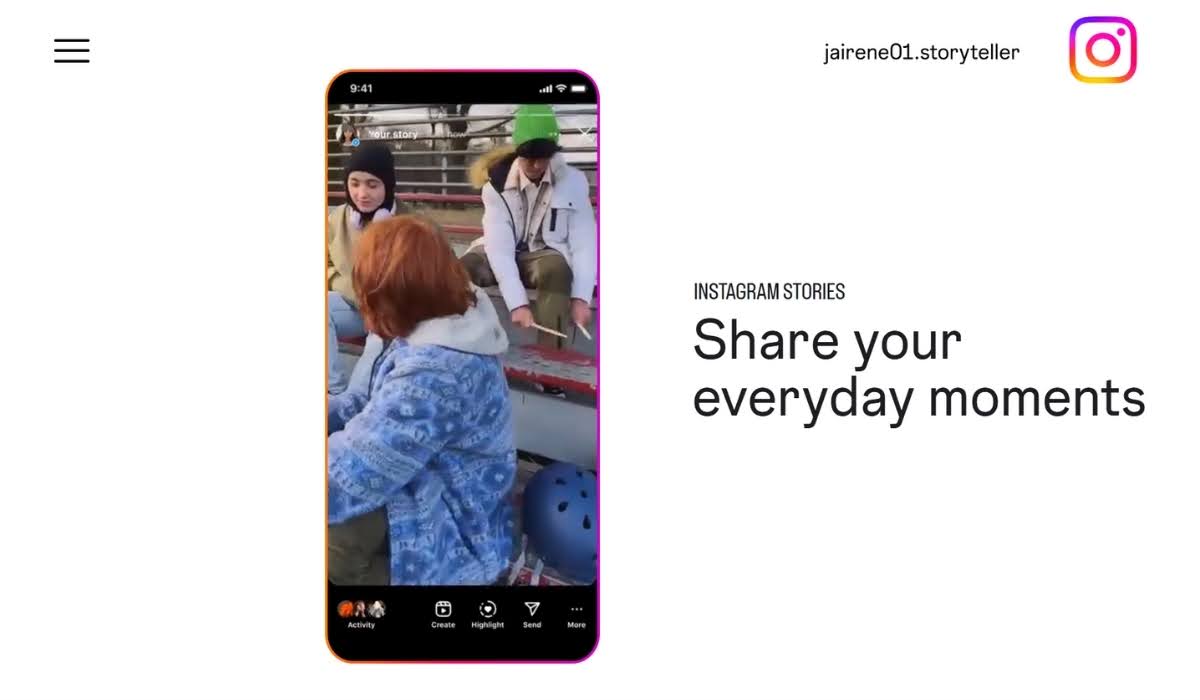
Paid Social Advertising
LinkedIn Lead Generation
For B2B target acquisition, LinkedIn offers surgical precision. Utilize Lead Gen Forms to capture intelligence without forcing platform switching.
You can target by professional indicators: job title, company size, industry, or specific capabilities.
How to set up LinkedIn Lead Generation:
- Open a LinkedIn Ads Campaign Manager account
- Select “Lead Generation” as primary objective
- Define target parameters using professional filtering options
- Create streamlined lead forms (remember: minimal fields maximize conversion)
- Design creative assets that align precisely with what the form offers
- Initiate with sufficient budget allocation ($25-50/day minimum for testing)
- Monitor cost-per-acquisition and lead quality metrics, adjusting based on performance
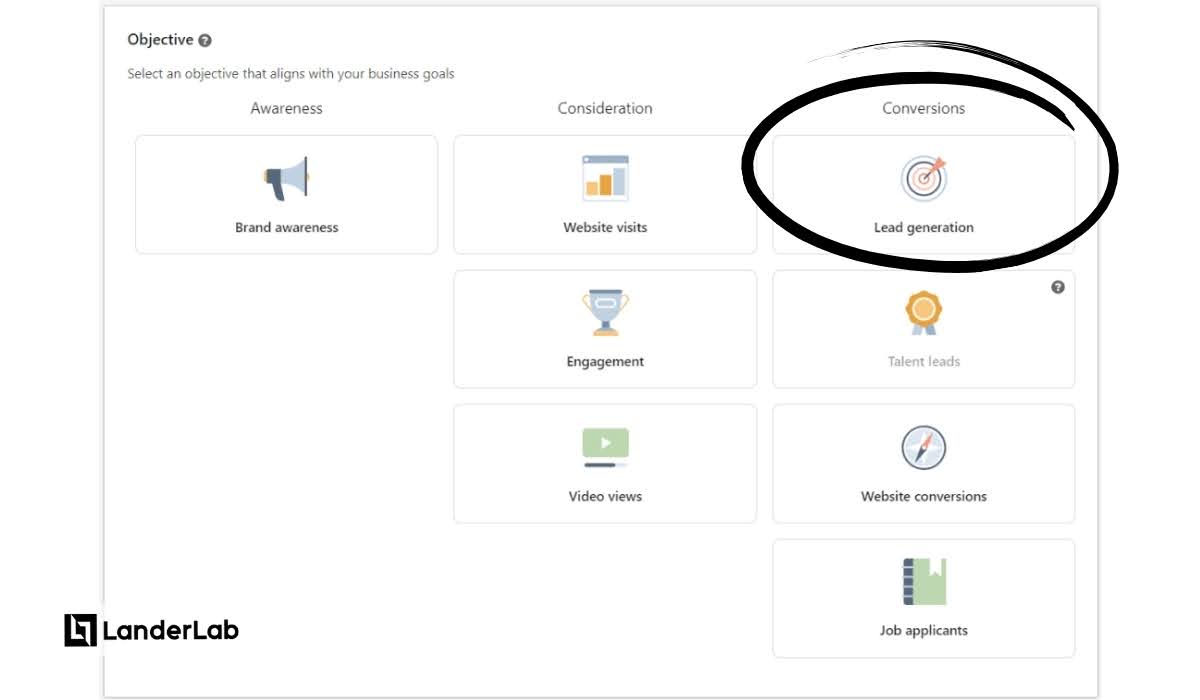
Facebook/Instagram Lead Generation
Meta Ads is ideal for B2C and select B2B operations. With it, you can deploy lookalike audience targeting based on your existing customer data.
And you can utilize Facebook Lead Ads for frictionless information capture within the platform, if you don’t want to use your own landing pages.
How to set up Facebook/Meta Lead Generation:
- Establish Meta Business Manager and Ads Manager account
- Install Meta Pixel on your landing page for tracking and audience building
- Select “Lead Generation” as primary objective
- Define target parameters using demographic, interest, and behavioral filters
- Create strategic lead forms (Limit to 5 fields maximum) (Utilize dropdown menus to minimize completion barriers) (Include required privacy policy documentation)
- Design attention-grabbing creative assets with clear value propositions
- Craft concise messaging that clearly communicates benefits
- Allocate minimum $20-30 daily budget for initial launch
- Implement immediate follow-up protocols for captured leads
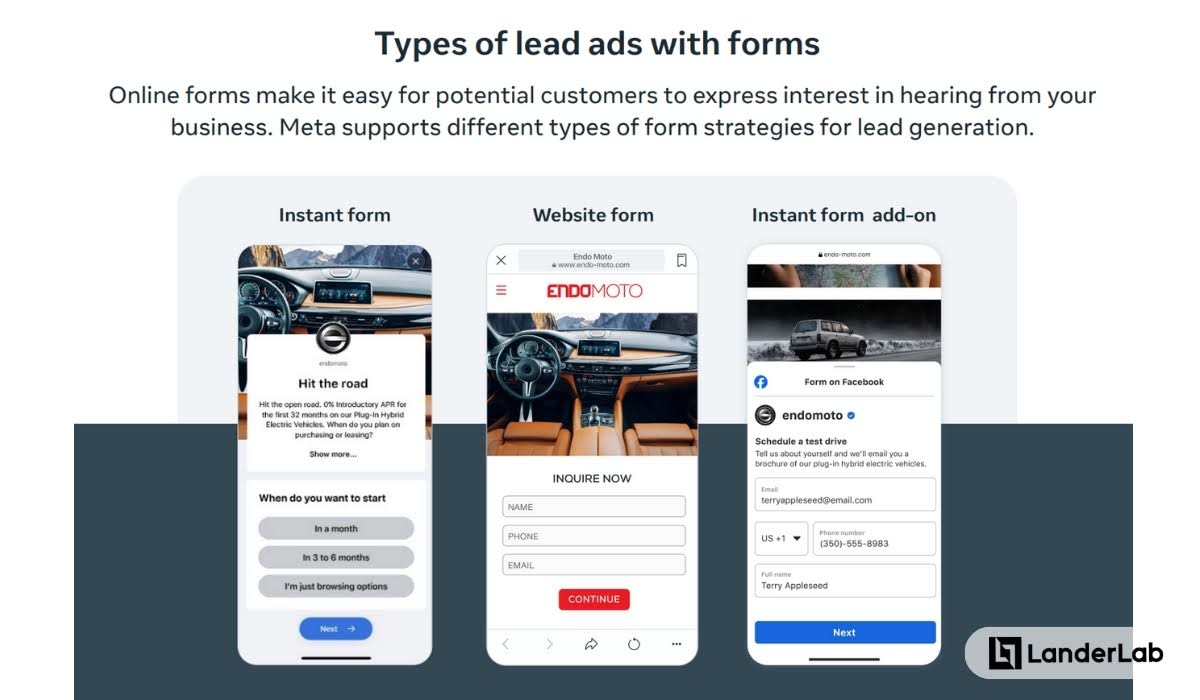
Pro Tip #1: Test single image, carousel, video, and story formats systematically to identify optimal engagement patterns for your specific targets.
Pro Tip #2: Add UTM parameter tracking to all links so you can identify which specific campaigns deliver the most valuable leads, not merely the highest volume.
4. Email Campaign Deployment: Direct Communication Channels
Email marketing remains one of the most effective direct communication channels for lead generation. It enables relationship development and strategic conversion over time.
You may think: I already have their email address, so the subscriber is already a lead. Yes and No.
Initial contact doesn’t make someone a qualified lead. Having an email address only means you have a point of contact, not a sales-ready prospect. Email marketing helps transform these contacts into qualified leads.
How to build an email marketing system:
- Create valuable lead magnets: Create high-value assets (guides, templates, tools) that merit email address exchange.
- Set up automated sequences: Develop strategic communication series that are automatically released to new subscribers. Design these sequences to systematically build trust and nurture leads toward decision points.
- Segment your target audience: Categorize subscribers based on behavioral signals, demographic indicators, or expressed interests to enable targeted messaging.
- Craft compelling subject lines: Test multiple approaches. Questions, numerical indicators, and personalization elements frequently outperform alternatives.
- Include clear and powerful calls to action: Ensure each communication contains one unmistakable primary action objective.
Pro Tip: Conduct regular database cleansing operations by removing inactive subscribers (no engagement for 3-6 months). This improves deliverability metrics and provides more accurate performance data.
5. Remarketing Operations: Target Reacquisition
Remarketing technology enables you to reconnect with prospects who demonstrated initial interest but didn’t complete desired actions. These targets typically convert at higher rates since they’ve already shown intent.
How to implement remarketing:
- Install tracking pixels: Add Facebook Pixel, LinkedIn Insight Tag, or Google Remarketing Tag across your websites and landing pages.
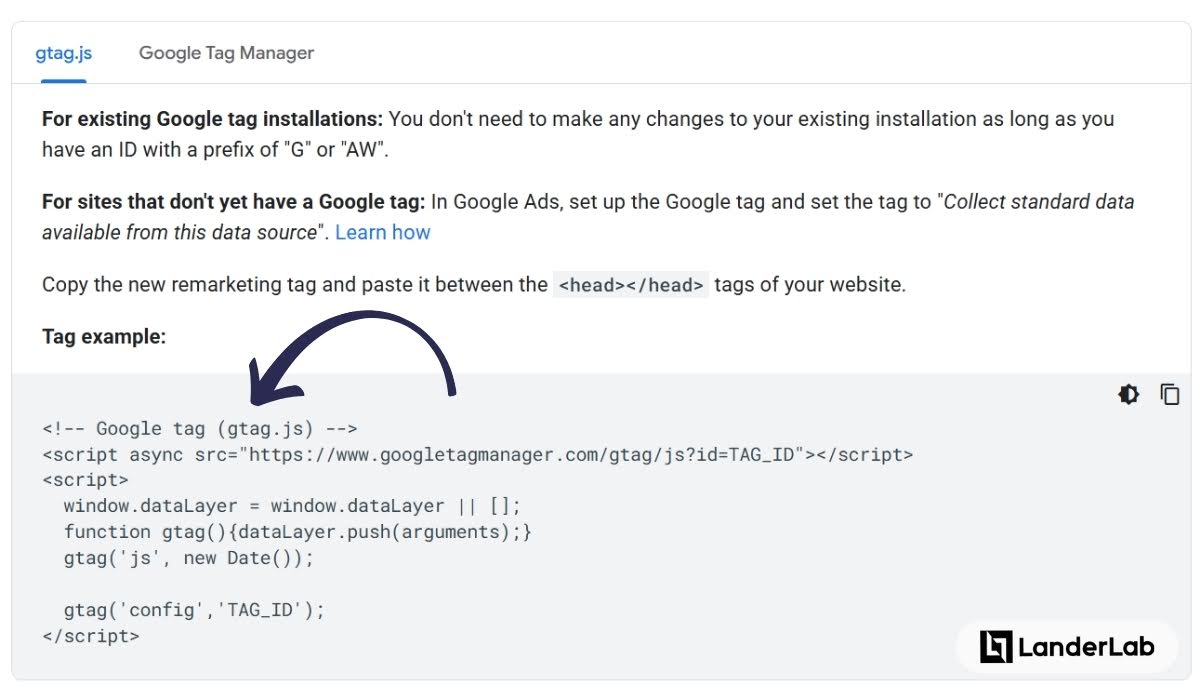
- Create specific audience segments: Create specific target lists based on engagement patterns or specific page visitation.
- Develop targeted messaging: Develop tailored communications addressing probable concerns or providing supplemental information based on previously demonstrated interests.
- Set frequency caps: Implement frequency caps to prevent messaging fatigue and negative brand perception.
- Create a logical sequence: Develop progressive message sequences rather than repetitive identical communications.
Pro Tip: Create specialized remarketing campaigns targeting form abandonment behavior. These “form abandoners” frequently convert at exceptional rates with minimal additional persuasion.
6. Display Advertising: Wide-Net Visibility
Display advertising enables brand visibility and lead generation across thousands of digital properties simultaneously.
How to create effective display campaigns:
- Use programmatic advertising: Utilize platforms like Google Display Network, or Media.Net for automated placement optimization.
- Create compelling visuals: Develop visuals with high stop power. Add some text with clear branding. Animated formats typically outperform static alternatives.
- Target strategically: Focus on specific websites, audience segments, or contextual placements rather than broad-spectrum approaches.
- Test multiple ad sizes: Create assets in primary format specifications (300×250, 728×90, 160×600) to maximize placement opportunities.

- Use data to optimize: Track placement performance, creative effectiveness, and audience response to continuously refine deployment.
Pro Tip: Create specialized landing environments optimized specifically for display traffic. Matching landing experiences to ad expectations significantly enhances conversion rates.
7. Native Advertising: Camouflaged Approach
Native advertising integrates with surrounding content environment, matching organic appearance. This format typically generates superior engagement by avoiding disruption patterns.
How to implement native advertising:
- Choose the right platforms: Launch through services like Outbrain, Taboola, and MGID to access premium publisher networks.
![lead generation channel native advertising]](https://wp.landerlab.io/wp-content/uploads/2025/07/lead-generation-channel-native-advertising.jpg)
- Create content-focused ads: Prioritize informative style over direct selling approaches. Headlines should promise specific beneficial information, not product promotion.
- Use high-quality images: Select images that appear contextually appropriate within publisher environments while maintaining attention-grabbing ads.
- Write compelling headlines: Develop multiple variants that generate curiosity or communicate clear benefits.
- Create dedicated landing pages: Create conversion environments that fulfill headline promises before requesting contact information.
Pro Tip: Use native formats to promote your highest-performing content assets rather than direct sales materials. This two-stage approach typically generates higher-quality leads.
8. Video Ads: Dynamic Engagement
Video advertising has become increasingly critical as consumption patterns shift across all platforms. It’s practically the most popular content type nowadays.
How to implement video advertising:
- Keep videos short: Maintain 15-30 second format for most platforms. Capture attention within the first 3 seconds or lose engagement.
- Design for sound-off viewing: Develop with captions or visual narrative techniques since many users view without audio. Often, outstream video ads that play automatically are muted to prevent them from becoming intrusive.
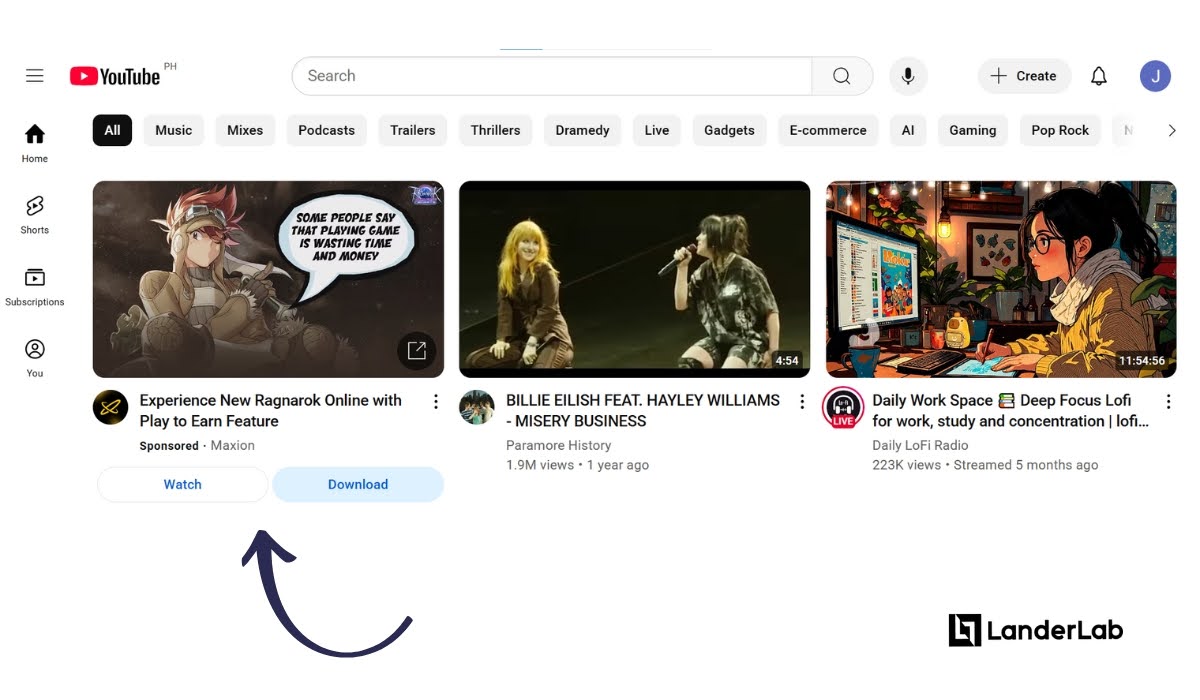
- Include clear calls to action: Provide unmistakable next-step instructions after viewing.
- Target strategically: Utilize in-market audiences, custom intent indicators, and remarketing to reach the highest-relevance viewers.
- Test different platforms: Evaluate performance across YouTube, Facebook, Instagram, and LinkedIn, each offering distinct audience characteristics. If you’re using outstream video ads (typically available in display ad networks), don’t forget to evaluate their performance, too.
Pro Tip: Create multiple versions at varying lengths (6, 15, and 30 seconds) to test performance metrics and deploy across different platform requirements.
9. Push Notification Ads: Direct Alert System
Push notification ads deliver messages directly to user devices even during inactive browsing periods. These are paid advertisements delivered through publishing websites’ opt-in subscriber lists, allowing you to reach users who have consented to receive notifications.
How to implement push notifications advertising:
- Ad network selection: Deploy through specialized advertising networks like PropellerAds, RichAds, MegaPush, and ZeroPark that offer push notification ad inventory.
- Payment model optimization: Choose between cost-per-view (CPV) or cost-per-click (CPC) models based on campaign objectives and budget constraints, or depending on what the platform offers.
- Traffic quality assessment: Evaluate networks based on the quality of their publisher websites and opt-in lists. Premium traffic sources typically deliver higher conversion rates despite higher costs.
- Message compression: Craft ultra-concise communications suitable for limited display space (typically 30-50 characters for titles, 40-120 for descriptions).
- Visual integration: Include compelling small-format images that enhance message impact without overwhelming the notification.
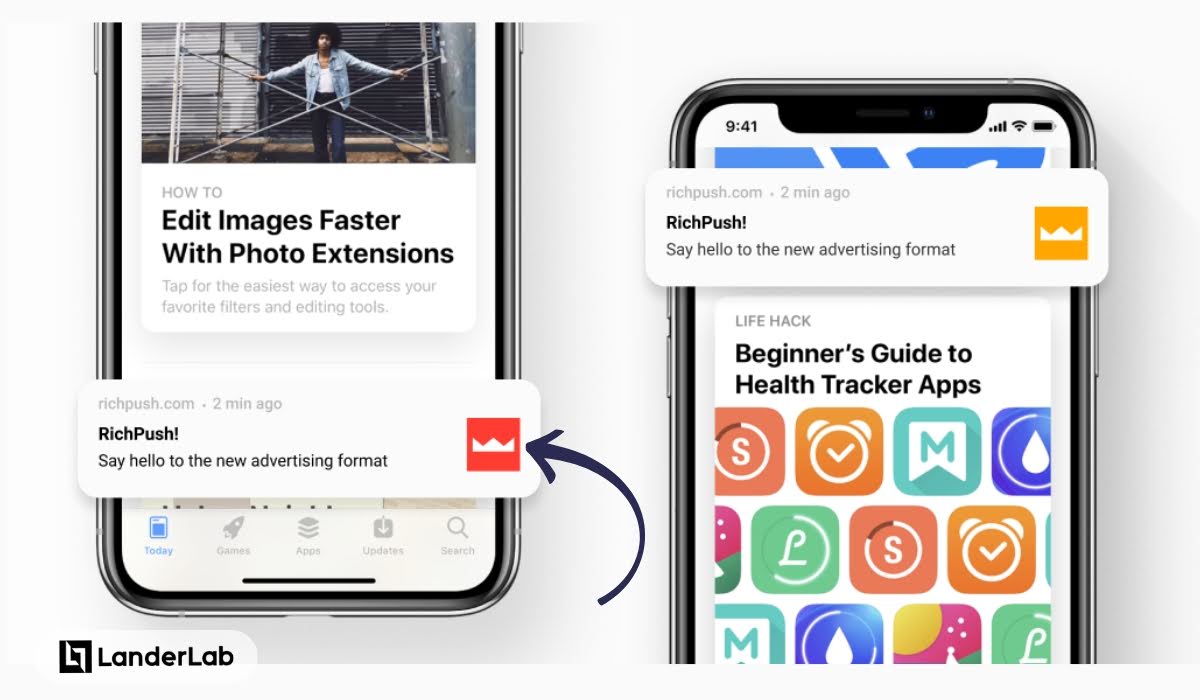
- Precise targeting: Utilize the network’s targeting capabilities for device types, operating systems, geographic locations, and user interests.
- Timing optimization: Deploy during periods of maximum receptivity for your specific audience segments.
Pro Tip: Unlike many ad formats, push notification ads reach users even when they’re not actively browsing, creating immediate visibility. Their opt-in nature means users have already consented to receive messages, reducing resistance compared to interrupt-based advertising.
10. In-App Advertising: Mobile Engagement
In-app advertising appears within mobile applications in various formats, reaching users during high-engagement moments.
How to implement mobile in-app advertising:
- Choose the right format: Choose from banners, in-feed, interstitials (full-screen between activities), rewarded videos (offering in-app value for viewing), and more.
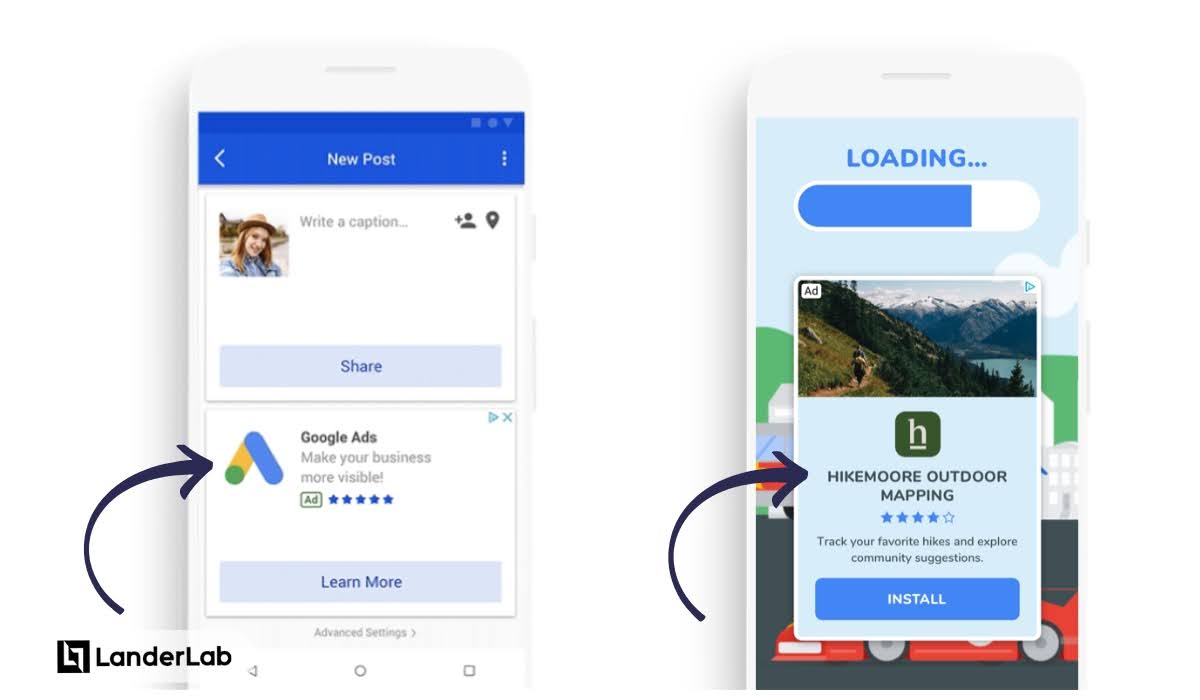
- Target relevant app categories: Focus on application categories with user bases matching your ideal customer profiles.
- Consider the user experience: Avoid formats that interrupt critical application functions or generate user friction.
- Use strong visuals: Mobile users respond best to clear, visually compelling creative elements.
- Test different networks: Test Google’s AdMob, ironSource, and AppLovin for inventory and targeting variations.
Pro Tip: Rewarded video typically generates the highest engagement metrics by providing explicit value exchange for attention.
11. Contextual Pop-Under & Domain Redirect Ads: Overlooked Opportunities
These often-dismissed methods can deliver surprising results when deployed strategically. However, instead of regular pop ads, go for contextual pop-unders and redirects. Contextual targeting provides critical performance enhancement through several implementation methods:
- Keyword-based targeting: Match your parameters against the publishing page URL/content
- Category/niche targeting: Select specific industry verticals aligned with your offer
- Site list targeting: Focus on domains with proven performance history
- Device and geo-layering: Combine contextual targeting with device types and locations
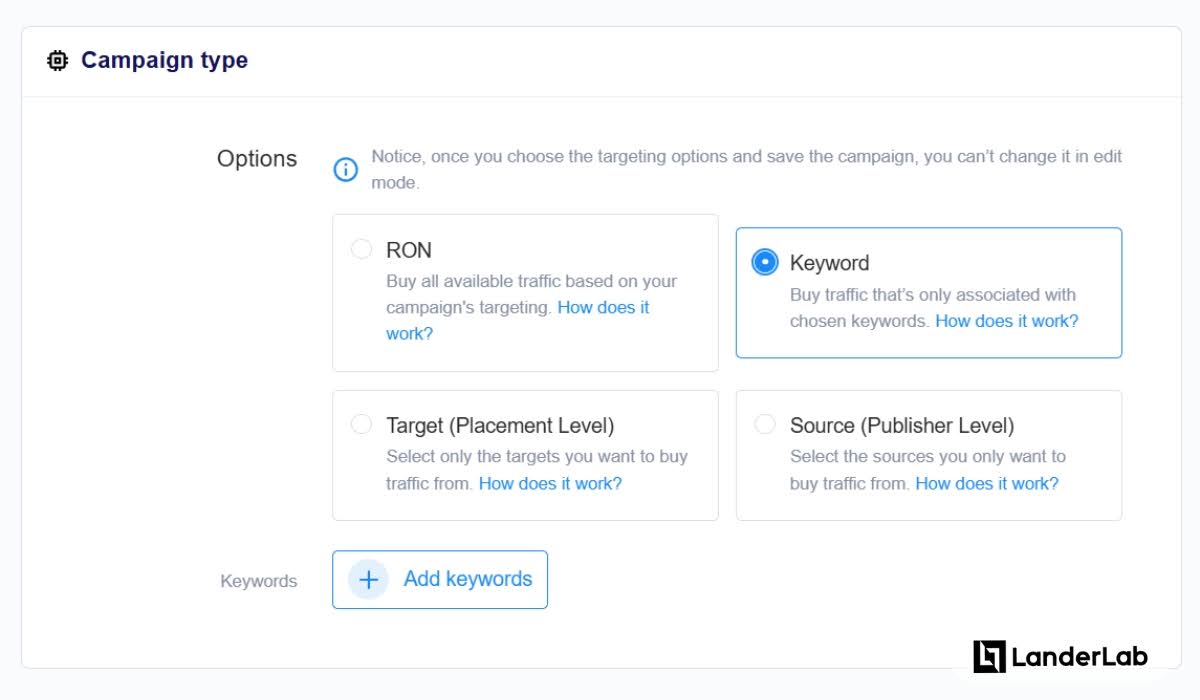
Pop-Up/Pop-Under Ads
Pop-under ads appear in new browser windows behind current pages, becoming visible upon main window closure. While considered intrusive by some, strategic implementation delivers results.
Pop-ups are only available on mobile nowadays.
How to use pop-under ads effectively:
- Create compelling landing pages: Since users discover your message after primary browsing, the landing page must immediately capture attention.
- Use clear value propositions: Articulate benefits within seconds of exposure.
- Test different networks: Major networks offering pop-under inventory include PropellerAds, Adcash, and PopAds.
- Implement frequency capping: Control exposure rates to prevent negative brand associations.
Domain Redirect Ads
Domain redirects capture traffic from parked or expired domains by redirecting visitors to your offer. This tactic effectively generates leads from users seeking specific content.
How to use domain redirect ads effectively:
- Network selection: Utilize advertising networks with PPV/domain redirect capabilities like PropellerAds and Zeropark.
- Select networks with quality traffic sources: Prioritize networks transparent about traffic sources and domain quality.
- Create targeted landing pages: Design specific conversion pages matching probable visitor intent.
- Test different bidding strategies: Begin conservatively until identifying the highest-performing domain categories.
- Monitor conversion metrics closely: These traffic sources vary significantly in quality; maintain strict performance monitoring.
Universal Tips for All Digital Advertising
Regardless of specific format deployment, two fundamental practices dramatically improve outcomes:
- Use dedicated landing pages
Never direct paid traffic to the general homepage territories. Create specific conversion environments for each lead generation campaign, matching message, offer, and audience characteristics. These pages require:
- Message consistency with the originating ad
- Singular, unmistakable call to action
- Minimal navigation options
- Mobile optimization
- Rapid loading performance
Don’t have the time and know-how to build landing pages from scratch? Use LanderLab’s templates. We have several lead generation landing pages for various industries.
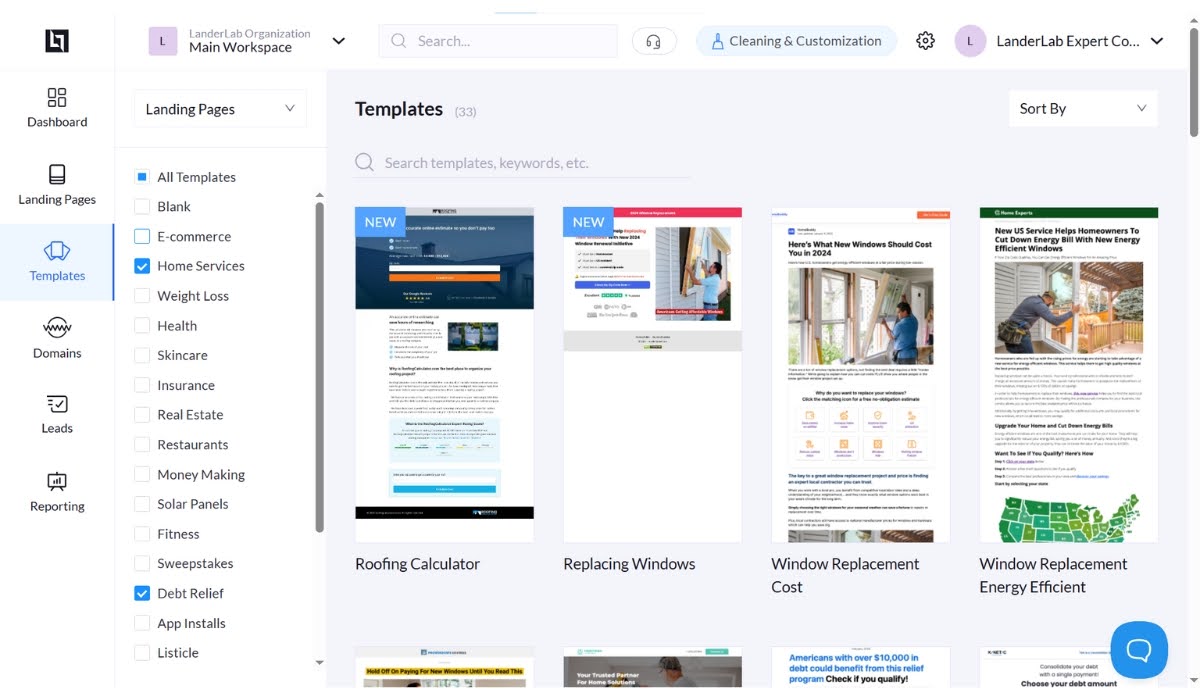
- Independent tracking infrastructure
Never rely exclusively on advertising platform reporting. Use independent verification through:
- Google Analytics or Matomo for behavioral analysis
- Performance marketing tracking tools like ClickFlare
- CRM integration for lead journey monitoring
- Attribution tools like Ruler Analytics or Dreamdata for comprehensive journey mapping
These protocols enable accurate ROI measurement, data-driven optimization, and intelligent budget allocation decisions for all your marketing efforts.
Face-to-Face Lead Generation Strategies
We won’t be talking about the traditional way of gathering leads offline. We’ll skip the usual ones and focus on those you might not have thought of. These are:
1. Trade Shows & In-Person Events: Direct Engagement
Face-to-face interactions at industry gatherings generate high-quality leads and accelerate relationship development processes. They remain one of the most effective lead generation channels for businesses looking to connect with qualified leads directly.
How to maximize lead generation at events:
- Set clear goals: Establish specific lead quantity targets and qualification criteria before event deployment.
- Create an attractive booth: Create space visually communicating value proposition and commanding attention.
- Train your team: Ensure all personnel understand lead qualification protocols, messaging priorities, and information collection requirements.
- Use technology wisely: Consider lead scanning applications, demonstration tablets, or digital content sharing capabilities.
- Create a compelling offer: Create compelling reason for information sharing, whether demonstration, exclusive content, or strategic giveaway.
- Follow up quickly: Contact high-potential leads within 24-48 hours post-event.
Pro Tip: Host intimate gathering near major conference rather than standard exhibition. Similar investment yields deeper connections with fewer, higher-quality prospects.
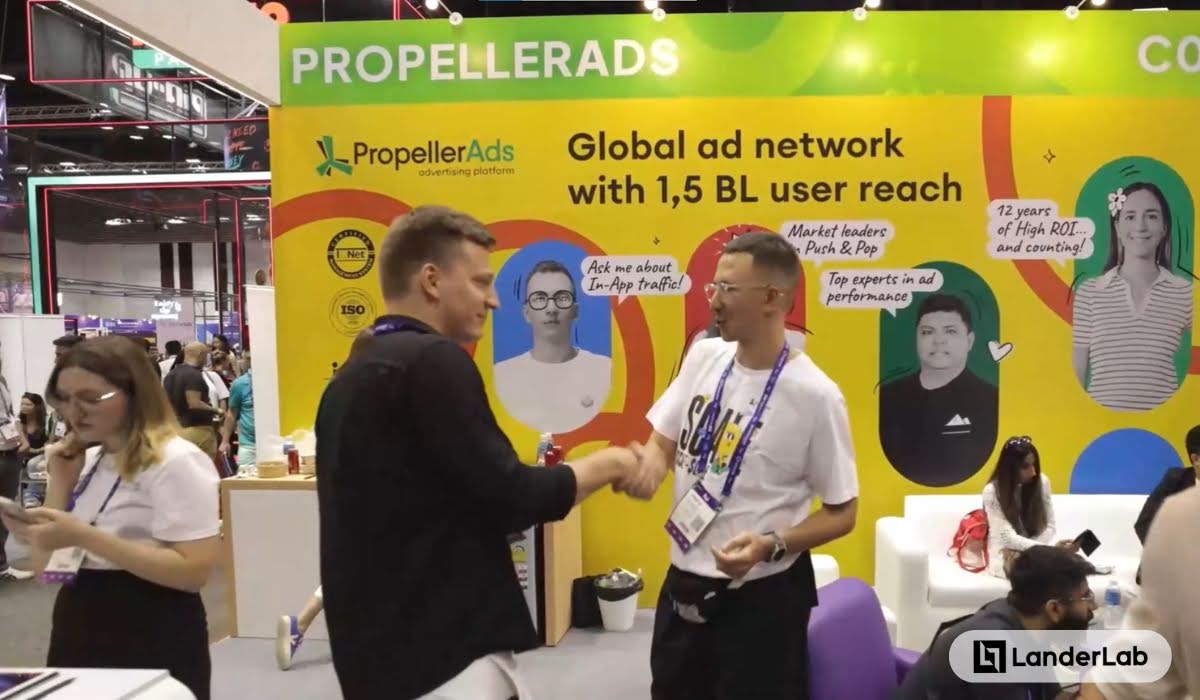
2. Public Speaking & Industry Presentations: Authority Positioning
Speaking engagements establish expert positioning and create connection opportunities with prospects already interested in your subject matter.
How to generate leads through speaking:
- Target relevant events: Target conferences, seminars, and gatherings attended by ideal customer profiles.
- Create valuable presentations: Deliver actionable insights rather than sales presentations. Address authentic audience challenges.
- Include a specific offer: Provide attendees compelling reason for post-presentation connection, such as assessment offer.
- Collect contact information: Offer presentation materials or supplemental resources to anyone providing email address.
- Follow up with attendees: Send customized communications referencing specific conversations or questions from your session.
- Repurpose your presentation: Transform presentation into blog content, video assets, or social media material extending reach beyond attendees.
Pro Tip: Volunteer for panel participation when dedicated speaking slots unavailable. This maintains expert positioning while requiring less preparation than comprehensive presentations.
Partnership-Based Lead Generation Strategies
Partnership approaches leverage external relationships to expand market reach. These methods typically produce higher-quality leads due to inherent trust transfer from referring entities.
1. Affiliate Marketing: Performance-Based Channel
Affiliate marketing enables recruitment of promotion partners compensated through commission structures. This creates performance-based sales channels with costs incurred only upon results delivery.
How to build an effective affiliate program:
- Set the right commission structure: Offer sufficient incentive to motivate partner action while maintaining profitability. Consider enhanced rates for top performers.
- Create promotional resources: Supply promotional assets including banners, email templates, social content, and additional marketing materials.
- Establish clear program rules: Clearly define acceptable promotion methods, commission calculation protocols, and payment schedules.
- Track performance accurately: Implement reliable affiliate tracking technology ensuring proper attribution to appropriate partners.
- Recruit the right affiliates: Identify partners already reaching your target audience without direct competitive overlap.
- Support your top performers: Provide additional resources, enhanced commission structures, or exclusive promotions to highest-producing affiliates.
Pro Tip: Implement tiered commission architecture rewarding affiliates not merely for individual transactions but consistent performance over time. This encourages long-term promotion commitment.
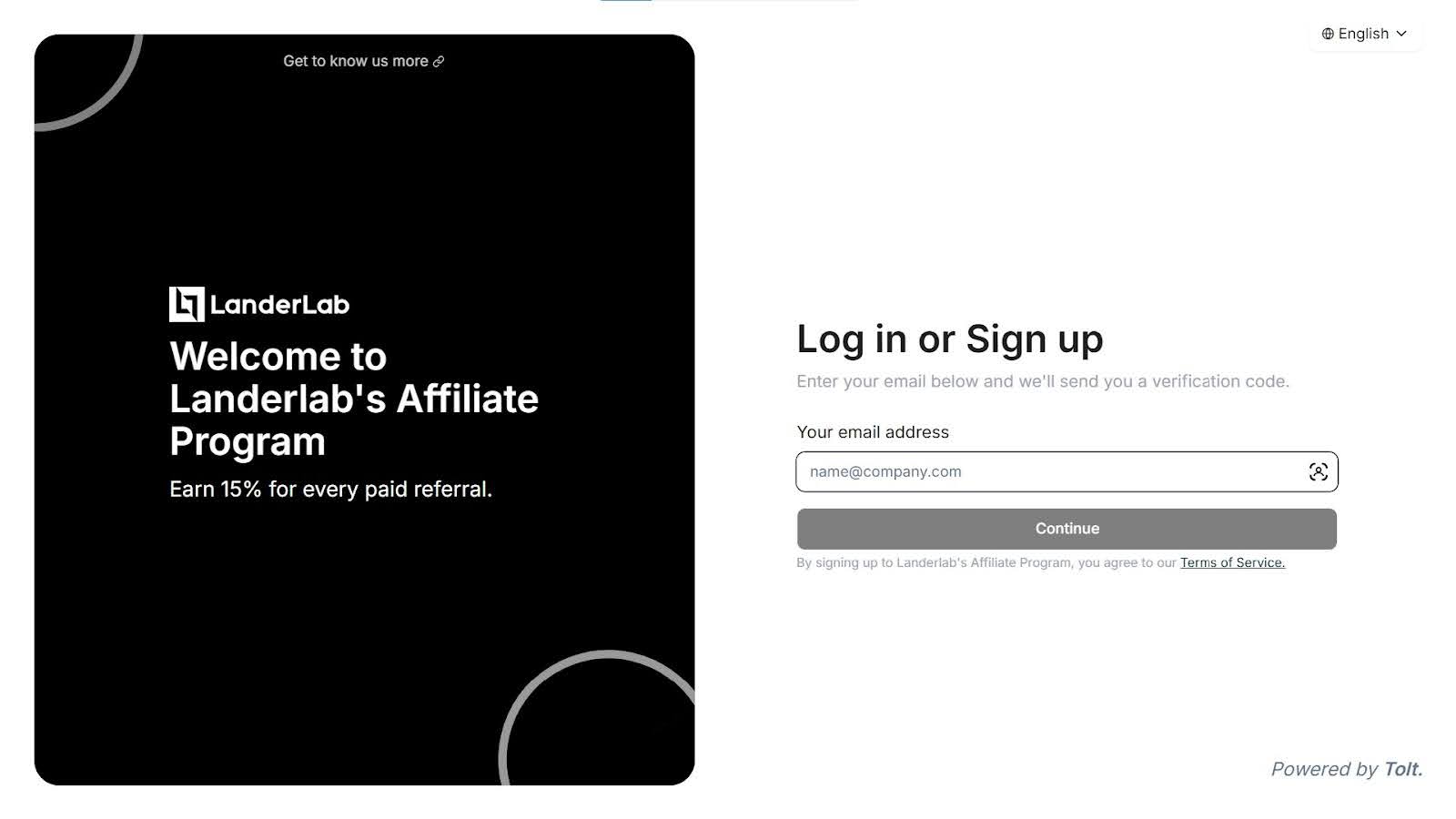
2. Influencer Marketing: Trust-Based Promotion
Influencer marketing partners your organization with individuals possessing established credibility and audience trust. This approach succeeds because recommendations from trusted sources carry greater impact than direct advertising.
How to implement influencer marketing:
- Identify relevant influencers: Seek individuals aligned with brand values already reaching your target audience. Micro-influencers (10,000-50,000 followers) often deliver higher engagement rates than celebrity-tier personalities.
- Establish clear objectives: Determine whether brand awareness, lead generation, or direct sales serve as primary campaign objectives.
- Create authentic partnerships: Collaborate on content creation feeling natural to established audience rather than forcing external messaging.
- Track results properly: Implement unique links, promotion codes, or landing pages to assess individual influencer performance.
- Build long-term relationships: Ongoing partnerships typically outperform single promotions as influencer audiences develop brand familiarity.
Pro Tip: Request influencer content addressing specific pain points your solution resolves rather than feature showcasing. This generates more qualified leads understanding your value proposition.
3. Cross-Promotion Campaigns: Strategic Alliances
Cross-promotion involves partnering with complementary (non-competing) organizations to access respective audiences. These partnerships significantly expand reach while minimizing cost structures.
How to create successful cross-promotions:
- Find the right partners: Seek businesses serving identical customer profiles with different product/service offerings.
- Develop mutually beneficial campaigns: Create promotions delivering equal value to both partners and respective customer bases.
- Start small and build:: Begin with simple collaborations like joint email features before advancing to complex initiatives.
- Share resources fairly: Clearly define how costs, leads, and customer data will be handled.
- Performance analysis: Measure results for both partners using this data to enhance future collaborations.
Effective Cross-Promotion Examples:
- Co-hosted webinars or events
- Bundled complementary product offers
- Reciprocal email newsletter features
- Co-branded content or resource development
- Exclusive discount exchange for respective customers
Pro Tip: Implement “content exchange” where each partner creates guest articles, podcast episodes, or video content for the other’s platform. This provides value to both audiences while establishing expertise.
4. Referral Programs: Customer Advocacy
Referral programs transform existing customers into lead generation partners by incentivizing business recommendations. Since people trust recommendations from personal connections, these leads frequently convert at superior rates.
How to build an effective referral program:
-
- Create compelling incentives: Offer rewards motivating customer referral activity. Consider dual-sided rewards benefiting both referrer and new customer.
- Make it easy to share: Provide simple sharing tools, pre-composed messages, and clear instructions.
- Program visibility: Ensure customer awareness through email communications, product messaging, and other contact points.
- Track referrals accurately: Implement software correctly attributing new customers to appropriate referral sources.
- Celebrate success stories: Share successful referral examples inspiring broader participation.
- Acknowledge performance: Recognize referral participants with personalized communications, not merely automated responses.
- Use referral marketing tools: To automate tracking and to make the launch of your referral program, use referral tools like Referral Candy or Viral Loops.
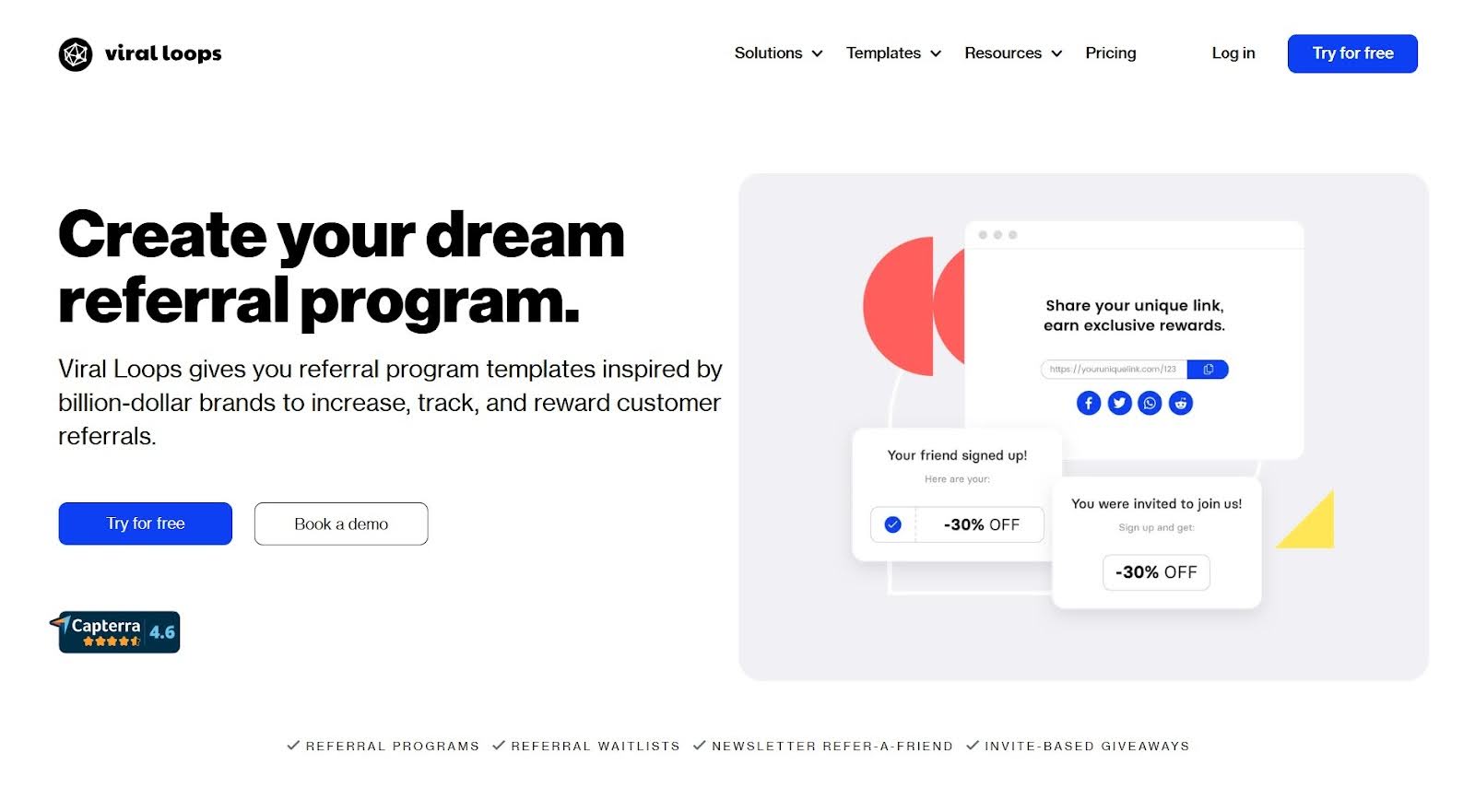
Pro Tip: Develop tiered referral architecture offering increasing rewards for multiple successful referrals. This encourages enthusiastic customers to become ongoing brand advocates.
5. Guest Content Contribution: Audience Expansion
Guest content contribution involves creating material for external websites reaching established audiences. This strategy builds authority while generating leads from new sources.
You might think that this is just like cross-promotion, but in reality, there’s a difference. Cross-promotion involves two brands mutually promoting each other’s products or content to their respective audiences, while guest posting specifically refers to creating content for another website or platform with attribution to the original author.
How to use guest blogging effectively:
- Target the right publications: Focus on platforms reaching ideal customers with engaged audiences.
- Pitch relevant topics: Suggest content concepts providing value to publication readers while subtly demonstrating your expertise.
- Create exceptional content: Deliver premium work creating strong impression with new audience.
- Include a compelling bio: Craft author description clearly explaining your value proposition and why readers should establish connection.
- Add a specific call-to-action: Direct readers to dedicated landing page with relevant offer, not general homepage.
- Engage with comments: Respond to questions and discussion on your guest content building relationships with readers.
Pro Tip: Create unique lead acquisition asset specifically related to guest content topic. This contextually relevant offer will convert significantly higher than generic newsletter subscription.
Use these Lead Gen Channels Strategically!
Optimal lead generation requires multiple tactical combinations rather than depending on a singular approach. By deploying digital, traditional, and partnership-based methods strategically, you can:
- Reach prospects at various buying journey stages through your sales funnel
- Connect through preferred communication channels
- Protect against algorithm modifications or platform policy changes
Begin by selecting 2-3 strategies best aligned with your target audience characteristics and resource capabilities. Establish specific objectives and implement one channel at a time. Remember, quality leads consistently outperform quantity metrics.
Focus on attracting prospects genuinely matching ideal customer profiles and create processes to nurture leads through your sales pipeline.
Maintain regular performance assessment of your lead generation efforts, test new approaches, and implement improvements based on data analysis. Measure the success of your lead generation campaigns against clear KPIs.
With consistent execution of these successful lead generation strategies, you can establish a sustainable lead generation system that generates qualified leads consistently, fueling business growth long-term.
Ready to Turn Strategy into Results?
Start building high-converting lead generation landing pages today with LanderLab. Import existing pages or launch from proven templates—no coding needed.

